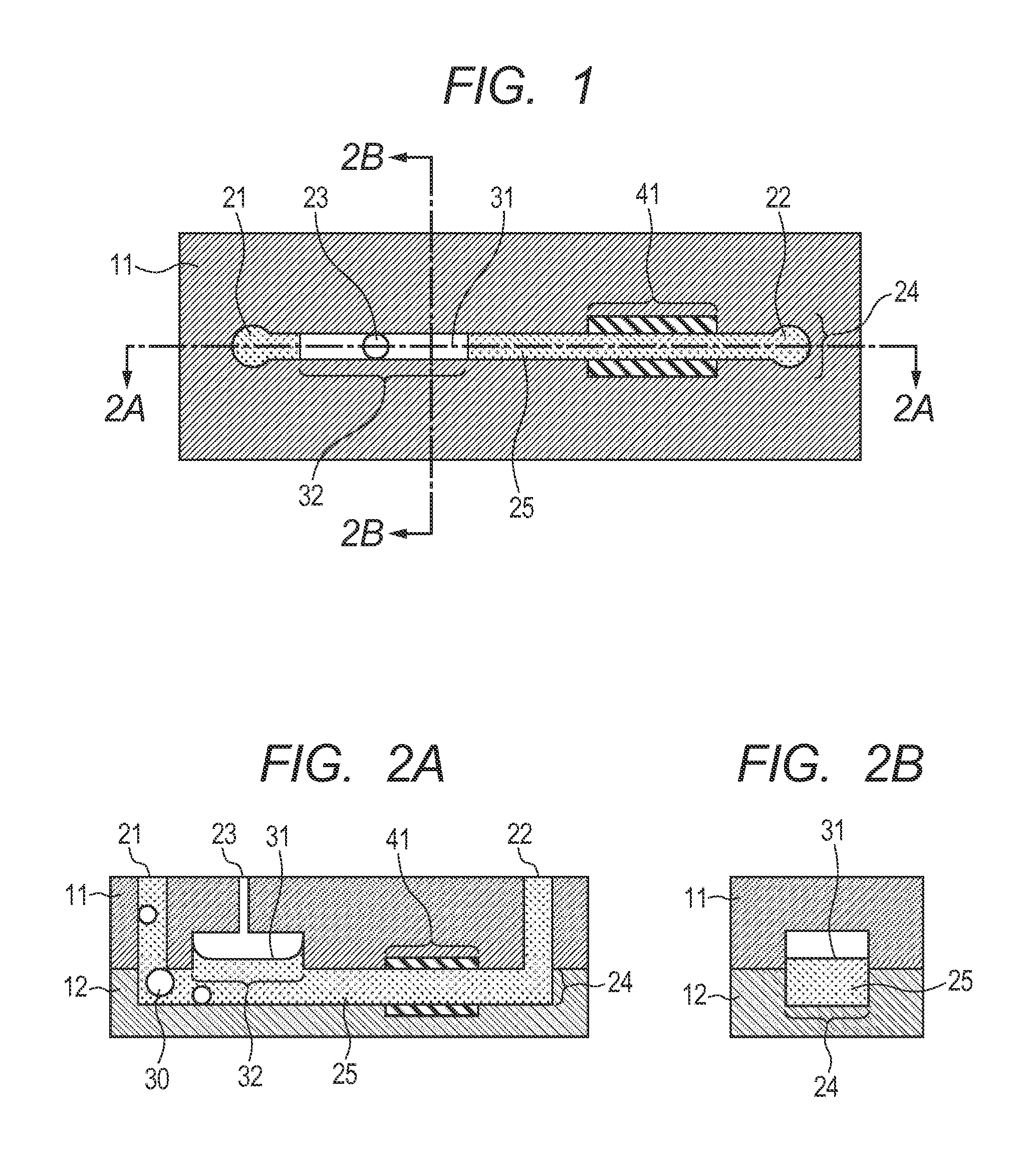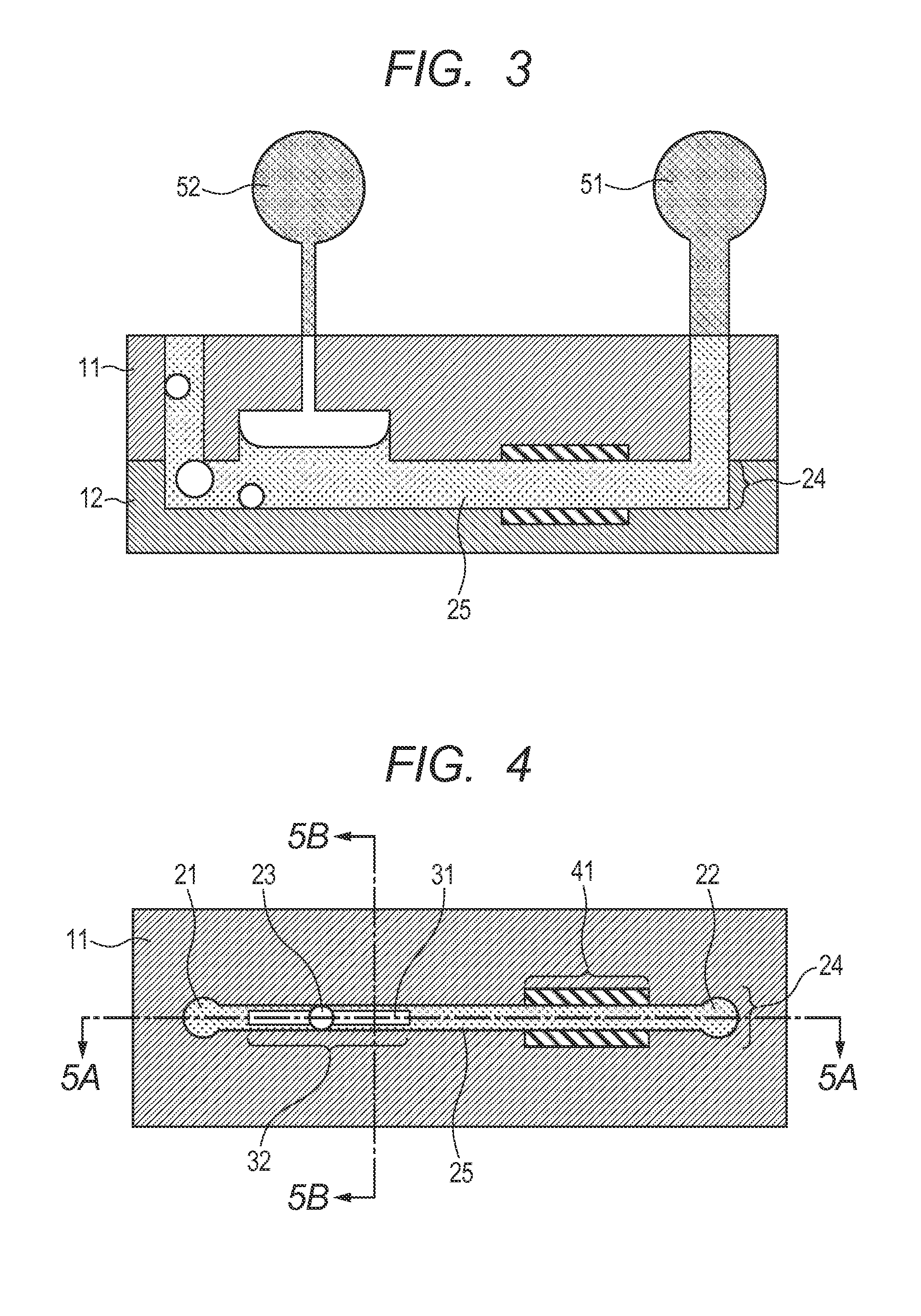Micro-channel device
a microchannel device and microchannel technology, applied in the direction of positive displacement liquid engine, laboratory glassware, instruments, etc., can solve the problems of reaction product emission, reaction product not being produced, and the quantity of liquid that a microchannel device can contain is very small
- Summary
- Abstract
- Description
- Claims
- Application Information
AI Technical Summary
Benefits of technology
Problems solved by technology
Method used
Image
Examples
example 1
[0062]Now, the present invention will be described further in greater detail by way of examples. Micro-channel devices were prepared in the examples that will be described below by applying the arrangement described above for the embodiments.
[0063]Quartz substrates were brought in as the material of the substrates to be used in this example and substrates having respective profiles as illustrated in FIGS. 1, 2A and 2B were obtained. Each of the substrates had a width of 60 mm, a depth of 30 mm and a thickness of 0.6 mm. The obtained substrates included the second substrate 12 having a groove (horizontal width: 180 μm, vertical width: 20 μm) that eventually became a micro-channel 24 and the first substrate 11 having a liquid injection port 21 (diameter: 0.35 mm), a liquid discharge port 22 (diameter: 0.35 mm), a recess (horizontal width: 180 μm, vertical width: 80 μm, length: 5 mm) that eventually became a bubble trapping region 32 and had a profile matching the profile of the groove...
example 2
[0071]Quartz substrates were brought in as the material of the substrates to be used in this example and substrates having respective profiles as illustrated in FIGS. 4, 5A and 5B were obtained by dry etching. Each of the obtained substrates had a width of 60 mm, a depth of 30 mm and a thickness of 0.6 mm. The obtained substrates included the second substrate having a groove 24 (horizontal width: 180 μm, vertical width: 20 μm) that eventually became a micro-channel and the first substrate 11 having a liquid injection port 21 (diameter: 0.35 mm), a liquid discharge port 22 (diameter: 0.35 mm) and a gas passage 23 (diameter: 0.35 mm).
[0072]The bubble trapping region (horizontal width: 180 μm, vertical width: 80 μm, length: 3 mm) having a profile of running along the groove of the second substrate was made to represent a triangular cross section that was tapered in the height direction as illustrated in FIG. 5B by wet etching so as to produce a gas-liquid interface in an apex part of t...
example 3
[0075]Quartz substrates were brought in as the material of the substrates to be used in this example and substrates having respective profiles as illustrated in FIGS. 6, 7A and 7B were obtained by dry etching. Each of the obtained substrates had a width of 60 mm, a depth of 30 mm and a thickness of 0.6 mm. The substrates included the second substrate having a groove 24 (horizontal width: 180 μm, vertical width: 20 μm) that eventually became a micro-channel and the first substrate 11 having a liquid injection port 21 (diameter: 0.35 mm), a liquid discharge port 22 (diameter: 0.35 mm) and a gas passage 23 (diameter: 0.35 mm).
[0076]The bubble trapping region (horizontal width: 180 μm, length: 3 mm) having a profile of running along the groove of the second substrate was made to represent a sloped cross section such that the height of the bubble trapping region 32 increased toward the downstream side by drilling so as to produce a gas-liquid interface 31 in an apex part of the sloped cr...
PUM
| Property | Measurement | Unit |
|---|---|---|
| width | aaaaa | aaaaa |
| width | aaaaa | aaaaa |
| depth | aaaaa | aaaaa |
Abstract
Description
Claims
Application Information
 Login to View More
Login to View More - R&D
- Intellectual Property
- Life Sciences
- Materials
- Tech Scout
- Unparalleled Data Quality
- Higher Quality Content
- 60% Fewer Hallucinations
Browse by: Latest US Patents, China's latest patents, Technical Efficacy Thesaurus, Application Domain, Technology Topic, Popular Technical Reports.
© 2025 PatSnap. All rights reserved.Legal|Privacy policy|Modern Slavery Act Transparency Statement|Sitemap|About US| Contact US: help@patsnap.com



